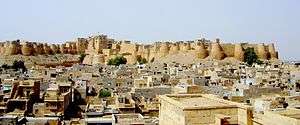Bhati

Bhati (also spelled Bhatti)[1] is a clan of Gurjars[2] and Rajputs[3] found in India and Pakistan.[4] The Bhati Rajputs (also known as Bargala) claim Chandravanshi origin.[5]
The original name of the Bhati clan was Yadav, reflecting their descent from Lord Krishna and the Yadu or Yadav.[6][7]
Bhati Rajputs ruled Jaisalmer in the 12th century. These people were camel riders, warriors and fond of cattle theft and hunting. Being located deep in the desert, Jaisalmer escaped direct Muslim conquest during the Muslim expansion in India but were eventually defeated by the Muslims nonetheless.[8]
Some Bhatis were nomadic cattle-keepers. In the years preceding the Indian rebellion of 1857, these groups lost land by decisions made by the British East India Company, which assigned to Jat peasants grazing lands formerly frequented by the Bhatis in the Delhi and Haryana regions. The British were not enamoured of nomadic tribes, whom they thought exacted protection in the areas that they visited, and the policies of land reform were designed in part to limit this mobility.[9]
At least some of the Bhati Rajput of Rajasthan were among the communities that practised female infanticide between 1883-1998.[3] One princess, a daughter of the Hindu Bhati Rajput ruling family in Dipalpur, was married to Salar Rajab, a Muslim ruler, and gave birth to Firuz Shah Tughlaq. This was one of several examples of inter-religious royal marriage alliances during the period of Turkic Muslim rule in India.[10] Rajput Bhati princesses were also married into the royal family of Jodhpur.[11]
In some parts of modern Pakistan, especially in the Northern and Central Punjab, low-caste doms (or Mirasi singers/dancers) now also call themselves 'Bhattis'; a fact deeply resented by the authentic Bhatti Rajputs of Pakistan.[12] Bhati gurjars mainly resides in area surrounding Delhi and uttar pradesh, the part of bulandShehr, ghaziabad and gautam Buddha Nagar is known as bhatner. The bhati gurjars have 365 villages in this area.
See also
References
- ↑ Babb, Lawrence A.; Cort, John E.; Meister, Michael W. (2008). Desert Temples: Sacred Centers of Rajasthan in Historical, Art-historical, and Social Context. Rawat Publications. p. 98. ISBN 978-8-13160-106-8.
- ↑ Singh, Kumar Suresh, ed. (1998). India's communities. Oxford University Press. ISBN 978-0-19-563354-2.
The Hindu Gujjar have a number of clans (gotra), such as Bainsale, Bhati, Bankar, Korri, Dhame, Godhane, Khari, Nangari, Khatana Pedia, Peelwar, Tanwar, Fagna, Vidhuri, Vasatte and Lomor
- 1 2 Bhatnagar, Rashmi Dube; Dube, Reena (2005). Female Infanticide in India: A Feminist Cultural History. SUNY Press. p. 254. ISBN 978-0-79146-327-7.
- ↑ Zafar Iqbal Chaudhary (November 2009). "Epilogue: Bridging divides". Epilogue. 3 (11): 48.
- ↑ Singh, Kumar Suresh, ed. (1998). India's communities. Oxford University Press. p. 301. ISBN 978-0-19-563354-2.
Bargala, also known as Bhati Rajput, the Bargala live in Uttar Pradesh. They trace their origin to Chandravanshi Rajput ruler Jagpalii Vare Singh
- ↑ Bose, Melia Belli (2015). Royal Umbrellas of Stone: Memory, Politics, and Public Identity in Rajput Funerary Art. BRILL. p. 8. ISBN 9789004300569. Retrieved 23 October 2016.
- ↑ Chowdhury, Sandeep Silas ; foreword by Renuka (2005). Discover India by rail (2nd rev. ed. ed.). New Delhi: Sterling Paperbacks. p. 233. ISBN 9788120729391. Retrieved 23 October 2016.
- ↑ John Middleton (2015). World Monarchies and Dynasties. Routledge. p. 765. ISBN 978-1-31745-158-7. Retrieved 6 March 2016.
- ↑ Bayly, Christopher Alan (1990). Indian Society and the Making of the British Empire (Reprinted ed.). Cambridge University Press. pp. 143, 188–189. ISBN 978-0-52138-650-0.
- ↑ Sarkar, Jadunath (1994) [1984]. A History of Jaipur (Reprinted, revised ed.). Orient Blackswan. p. 37. ISBN 978-8-12500-333-5.
- ↑ Karve, Irawati Karmarkar (1968). Kinship Organization in India (Third ed.). Asia Publishing House. p. 168.
- ↑ Dr M Riyasat Husain 'Caste and clan in Northern and Central Punjab and some patterns of shift: An analysis' in Journal of South Asian Study Vol 2, No 8, 1992, Lahore, pp 21-46